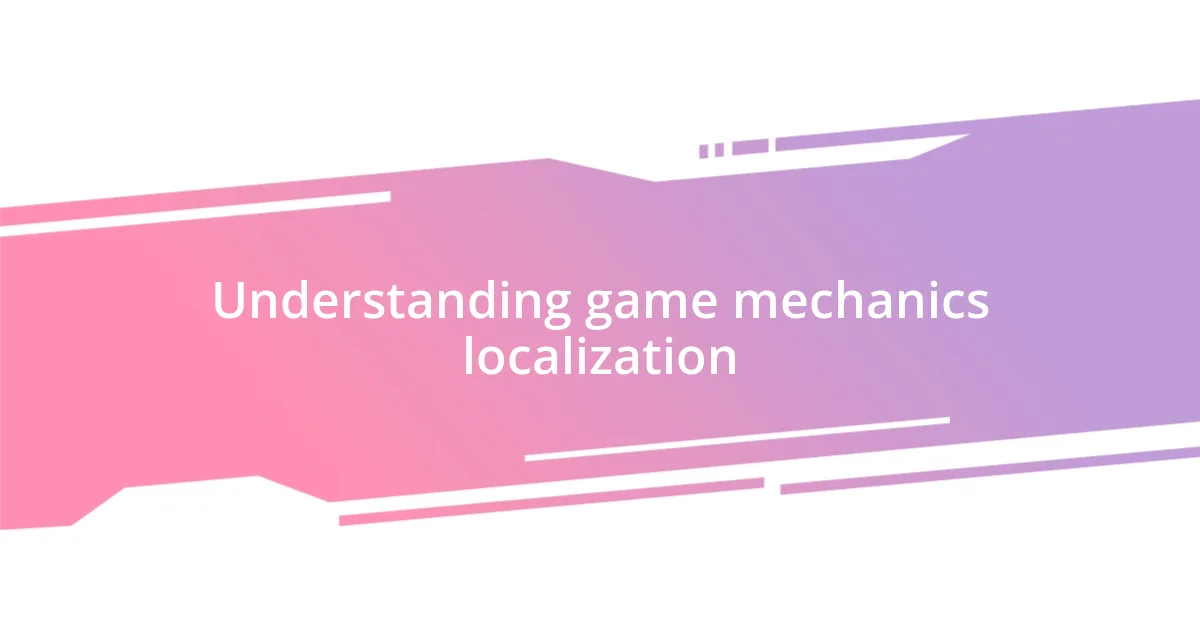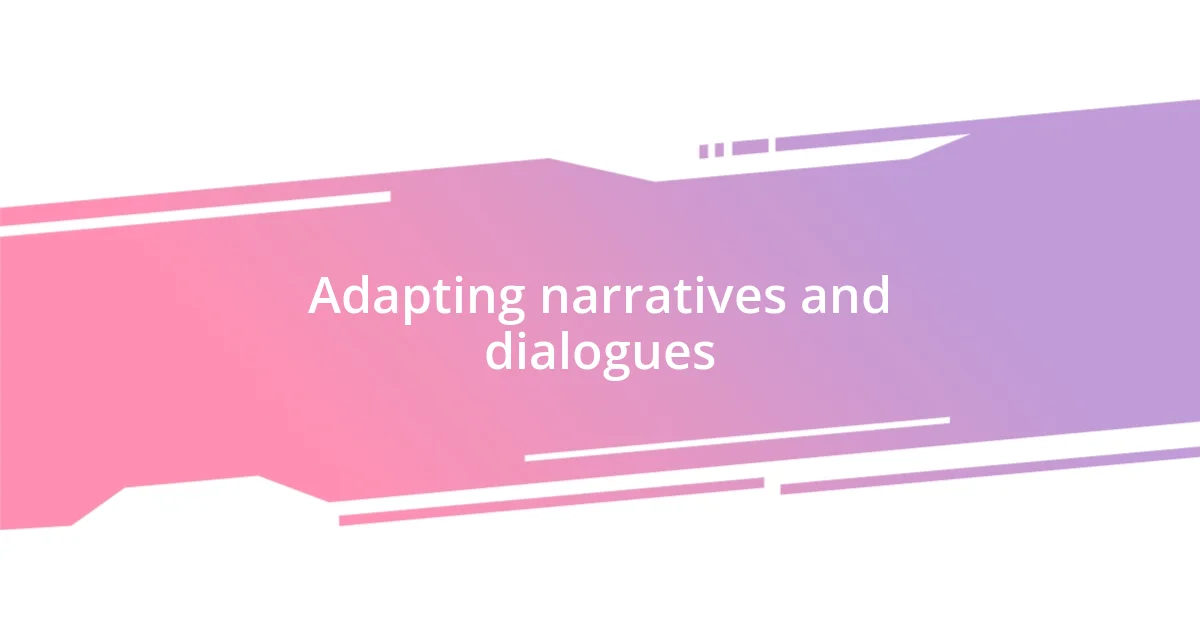Key takeaways:
- Understanding cultural nuances is essential for effectively localizing game mechanics, ensuring players emotionally connect with the game.
- Regular feedback from diverse player groups during testing reveals critical insights, allowing for meaningful adjustments that enhance player experience.
- Localization is an ongoing process that benefits from continuous improvement and engagement with the player community, fostering stronger connections and adapting to their preferences.

Understanding game mechanics localization
Understanding game mechanics localization is crucial for creating an immersive experience for players across different cultures. I recall a time when I adapted a puzzle game for the Japanese market. The original mechanics relied on Western cultural references that fell flat; players simply didn’t connect. This experience taught me how vital it is to consider the cultural context behind game mechanics.
Game mechanics aren’t just about rules; they’re about the emotions they evoke. I often think about how a simple mechanic like resource management can resonate differently in various cultures. For instance, in some societies, collaboration is prized over individual achievement, so adapting mechanics to encourage team play made a significant difference. Have you ever noticed how gameplay can shift based on cultural values? That’s the kind of insight that can elevate a game’s reception.
When I localized a combat game, I had to rethink the in-game feedback systems. Players in some regions respond well to direct rewards, while others appreciate more subtle cues. Adapting the game not only improved player engagement, but it also felt deeply rewarding to see players connect with the game in a way I had never anticipated. This transformation underlined the importance of understanding not just what players do, but how they feel about their interactions with game mechanics.

Analyzing cultural differences
Analyzing cultural differences requires an attentive eye and an open mind. I once worked on a casual mobile game that included humor unique to a specific culture. After launching, I quickly realized that jokes that landed perfectly at home fell flat elsewhere. It was a humbling lesson that humor isn’t universal; it can be a reflection of deep cultural values. Adapting the game to incorporate region-specific humor not only made it more engaging but also reinforced my belief in the importance of cultural sensitivity in game design.
In my experience, visual elements are another layer where cultural differences often manifest. While some players appreciate vibrant colors and dynamic animations, others may find them overwhelming or distracting. I once adjusted a game’s UI for a market accustomed to minimalism and subtlety. The result was staggering; the player feedback turned from confusion to delight. This experience solidified my understanding that cultural preferences aren’t just aesthetics—they influence user experience at a foundational level.
To draw another comparison, I’ve seen how player interactions can differ based on societal norms. In some cultures, direct competition is embraced; in others, it may be viewed as rude. Adapting competitive game mechanics to promote friendly interactions rather than cutthroat rivalries significantly improved player satisfaction. This taught me that understanding cultural backgrounds is not merely beneficial but essential for crafting immersive gaming experiences that resonate well with diverse audiences.
| Cultural Element | Example Adaptation |
|---|---|
| Humor | Localized jokes reflecting cultural nuances |
| Visual Preferences | UI changes for minimalism versus vibrancy |
| Social Interaction | Encouraging collaboration over competition |

Identifying key gameplay elements
Identifying key gameplay elements can be a complex but rewarding endeavor. It requires a deep understanding of not only the game mechanics but also the cultural context in which they will be experienced. For example, while working on a multiplayer strategy game, I noticed that certain mechanics—like resource scarcity—could evoke different reactions depending on the players’ backgrounds. In cultures that value frugality, scarcity worked well as a motivational tool, while in others, it felt oppressive. This highlights why I strive to recognize which gameplay elements resonate most profoundly with players before adapting them.
When I dig into gameplay elements, I often hone in on the following aspects:
- Core Mechanics: These are the very basics that define how players interact with the game. I’ve learned to analyze these critically, as even the smallest adjustment can change player experience drastically.
- Cultural Significances: Some mechanics might symbolize different values across cultures. A battle royale may be viewed as a fight for survival in one culture and as a sport in another.
- Player Emotion: Understanding emotional triggers is vital. Some players crave excitement, while others may prefer calm strategies. Knowing how these elements interact can lead to more successful adaptations.
- Feedback Systems: Different cultures might appreciate various forms of feedback, such as immediate rewards or more subtle indicators of achievement, which can significantly affect player satisfaction.
- Narrative Elements: The storyline can deeply affect how players relate to the game. A culturally relevant narrative can enhance engagement and make mechanics more meaningful.
I recall a specific situation where I modified the player progression system in an RPG. In one region, players were used to linear progression and clear milestones, while in another, they enjoyed exploring different paths at their own pace. Adjusting the progression mechanics to balance these preferences not only made the game more enjoyable but also opened my eyes to how pivotal these key elements are in enhancing overall player experience. Understanding and identifying these elements isn’t just important; it’s essential to creating a game that truly resonates.

Adapting narratives and dialogues
Adapting narratives and dialogues is where storytelling really meets cultural nuance. I remember working on a game set in a fantasy world, which featured a central quest revolving around familial honor—an incredibly important theme in some cultures. However, in other regions, this concept didn’t resonate as strongly. I rewrote dialogues to reflect values that were more meaningful to players in those areas, like friendship and community. The feedback was illuminating; players felt more connected to the story, which made the experience richer and more relatable for them.
When it comes to dialogues, the phraseology matters just as much as the content. I once faced a challenging situation while localizing a character’s catchphrase that seemed humorous in its original language. I asked myself, could it carry the same punch in translation? After collaborating with local writers, I found a phrase that maintained the character’s spirit but replaced the humor with a clever idiom familiar to that audience. The result was a more engaging character that players loved, simply because the dialogue spoke their language—not just literally, but culturally too.
Emotional depth can also shift depending on how narratives are framed. In a project I worked on, there was a pivotal moment in the plot that involved a betrayal. Initially, the narrative leaned heavily into dramatic tension, but feedback indicated players from certain cultures preferred a focus on reconciliation and forgiveness. By rewriting that section, we not only maintained the game’s emotional gravity but also resonated with players on a deeper level. Isn’t it fascinating how a slight narrative tweak can transform a player’s perception? These experiences taught me that adapting narratives isn’t just about translation but about weaving understanding and empathy into every word spoken within the game.

Testing localized game mechanics
Testing localized game mechanics is often where the rubber meets the road. After I implement changes based on cultural insights, I like to conduct playtesting sessions that include players from different backgrounds. During one particular session, a mechanic that I thought was universally fun ended up confusing players from a culture less familiar with competitive gaming. It was eye-opening to see how their expression shifted from excitement to frustration, underscoring the importance of real-world feedback.
I also pay close attention to player reactions when they experience the game in its localized form. In one instance, I modified a puzzle-solving mechanic that involved intricate patterns. Players in one region embraced the challenge, while others viewed it as tedious. By closely observing their interactions and gathering immediate feedback, I learned that context heavily influences engagement. This iterative testing process ensures that I fine-tune mechanics to fit seamlessly within the cultural framework of the audience.
One of my most memorable testing experiences was when I introduced a time-restricted gameplay element to a strategy game. It was thrilling to watch players engage with it, but I noticed a stark difference in how they handled time pressure. In some cultures, the urgency was exhilarating and spurred creativity, while in others, it led to overwhelming stress. This revelation led me to adjust the timer mechanics—giving players different modes depending on their preferences. Can you see how essential it is to consider emotional responses during testing? Each adjustment not only refines the gameplay but also deepens my understanding of the diverse player psyche.

Gathering player feedback
Gathering player feedback is a critical step in the localization process. I often set up forums or surveys after testing sessions where players can share their thoughts. One experience that stands out was when players expressed confusion over a game’s in-game currency system. Their insights helped me realize that not only was the terminology unfamiliar, but the concept of micro-transactions, while common in some regions, was completely foreign in others. This feedback became invaluable for crafting clearer tutorials and explanations.
I remember a particularly enlightening focus group where players discussed their experiences with a character’s abilities. They found one ability too overpowered, which skewed their enjoyment. Initially, I was defensive, believing it balanced well from my perspective. But listening to their passionate debates revealed that what felt balanced to me didn’t translate universally. Adjusting that ability not only led to better gameplay but also fostered a deeper connection with the community—something that always brings a smile to my face.
After all is said and done, I always make sure to circle back once changes are made. I conducted a follow-up session to present the adjustments, and the reactions were overwhelmingly positive. It reinforced my belief that communication is key. Engaging with players not only enhances the game but builds trust and loyalty. Have you ever felt that genuine pride when you see players enjoying something you’ve created? It’s a rewarding experience that fuels my passion for this work.

Continuous improvement in localization
Continuous improvement in localization is a journey that requires vigilance and adaptability. I make it a habit to review player feedback regularly, and it surprises me how often I uncover new insights long after a game’s release. For instance, I once received an unexpected email from a player who pointed out that a seemingly innocuous character dialogue didn’t resonate with their cultural references. That revelation sparked a series of changes that enhanced the entire narrative arc for future players. Isn’t it fascinating how a single piece of feedback can cascade into broader improvements?
As time goes on, I’ve come to realize that localization isn’t a one-time event; it’s an ongoing conversation with the audience. One of my most rewarding experiences was launching an update based on community suggestions three months post-launch. I remember the excitement in our forums as we shared our roadmap for improvements. The feedback we received was overwhelming, with players passionately contributing ideas that I hadn’t even considered. This ongoing dialogue didn’t just improve our game—it strengthened the community and fostered a genuine bond among players and developers. Do you see how powerful that connection can be?
When I reflect on the development process, it often feels like a dance of iteration. I’ve learned that every adjustment I make can lead to unforeseen outcomes. I once revisited a level design after a localization review, only to find that changing a single mechanic not only improved playability for one demographic but also unintentionally thrilled players in another region. That moment was a reminder of how interconnected player experiences can be. Have you ever adjusted something in your work that unexpectedly resonated with a different audience? It’s moments like these that truly ignite my passion for localization.














